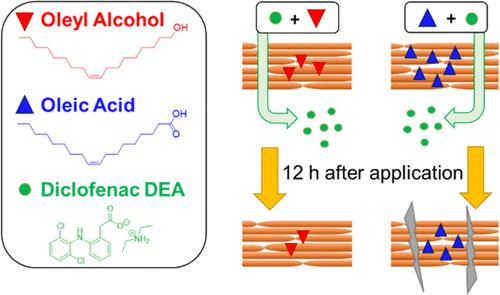当前位置:
X-MOL 学术
›
Mol. Pharmaceutics
›
论文详情
Our official English website, www.x-mol.net, welcomes your
feedback! (Note: you will need to create a separate account there.)
Time-Dependent Differences in the Effects of Oleic Acid and Oleyl Alcohol on the Human Skin Barrier
Molecular Pharmaceutics ( IF 4.5 ) Pub Date : 2023-11-11 , DOI: 10.1021/acs.molpharmaceut.3c00648 Andrej Kováčik 1 , Monika Kopečná 1 , Iva Hrdinová 1 , Lukáš Opálka 1 , Mila Boncheva Bettex 2 , Kateřina Vávrová 1
Molecular Pharmaceutics ( IF 4.5 ) Pub Date : 2023-11-11 , DOI: 10.1021/acs.molpharmaceut.3c00648 Andrej Kováčik 1 , Monika Kopečná 1 , Iva Hrdinová 1 , Lukáš Opálka 1 , Mila Boncheva Bettex 2 , Kateřina Vávrová 1
Affiliation

|
Oleic acid and oleyl alcohol are commonly used permeation and penetration enhancers to facilitate topical drug delivery. Here, we aimed to better understand the mechanism of their enhancing effects in terms of their interactions with the human skin barrier using diclofenac diethylamine (DIC-DEA), a nonsteroidal anti-inflammatory drug for topical pain management. Oleic acid promoted DIC-DEA permeation through ex vivo human skin more rapidly than oleyl alcohol (both applied at 0.75%) due to fluidization of stratum corneum lipids as revealed by infrared spectroscopy. After 12 h, the effect of these enhancers on DIC-DEA permeation leveled off, fluidization was no longer evident, and skin permeabilization was mainly due to the formation of fluid enhancer-rich domains. Contrary to oleyl alcohol, oleic acid adversely affected two indicators of the skin barrier integrity, transepidermal water loss and skin electrical impedance. The content of oleyl alcohol in the stratum corneum was lower than that of oleic acid (even 12 h after the enhancers were removed from the skin surface), but it caused higher DIC-DEA retention in both epidermis and dermis compared to oleic acid. The effects of oleyl alcohol and oleic acid on DIC-DEA permeation and retention in the skin were similar after a single and repeated application (4 doses every 12 h). Thus, oleyl alcohol offers several advantages over oleic acid for topical drug delivery.
中文翻译:

油酸和油醇对人体皮肤屏障的影响随时间的变化
油酸和油醇是常用的渗透和渗透促进剂,以促进局部药物递送。在这里,我们的目的是更好地了解它们使用双氯芬酸二乙胺(DIC-DEA)(一种用于局部疼痛管理的非甾体抗炎药)与人体皮肤屏障相互作用增强作用的机制。红外光谱显示,由于角质层脂质流化,油酸比油醇(均以 0.75% 的用量)更快地促进 DIC-DEA 通过离体人体皮肤的渗透。 12小时后,这些增强剂对DIC-DEA渗透的影响趋于平稳,流态化不再明显,皮肤透化主要是由于富含流体增强剂的域的形成。与油醇相反,油酸对皮肤屏障完整性的两个指标——经皮失水和皮肤电阻抗——产生不利影响。角质层中油醇的含量低于油酸(即使在增强剂从皮肤表面去除后12小时),但与油酸相比,它在表皮和真皮中引起更高的DIC-DEA保留。单次和重复施用(每 12 小时 4 剂)后,油醇和油酸对 DIC-DEA 渗透和保留在皮肤中的影响相似。因此,与油酸相比,油醇在局部给药方面具有多种优势。
更新日期:2023-11-11
中文翻译:

油酸和油醇对人体皮肤屏障的影响随时间的变化
油酸和油醇是常用的渗透和渗透促进剂,以促进局部药物递送。在这里,我们的目的是更好地了解它们使用双氯芬酸二乙胺(DIC-DEA)(一种用于局部疼痛管理的非甾体抗炎药)与人体皮肤屏障相互作用增强作用的机制。红外光谱显示,由于角质层脂质流化,油酸比油醇(均以 0.75% 的用量)更快地促进 DIC-DEA 通过离体人体皮肤的渗透。 12小时后,这些增强剂对DIC-DEA渗透的影响趋于平稳,流态化不再明显,皮肤透化主要是由于富含流体增强剂的域的形成。与油醇相反,油酸对皮肤屏障完整性的两个指标——经皮失水和皮肤电阻抗——产生不利影响。角质层中油醇的含量低于油酸(即使在增强剂从皮肤表面去除后12小时),但与油酸相比,它在表皮和真皮中引起更高的DIC-DEA保留。单次和重复施用(每 12 小时 4 剂)后,油醇和油酸对 DIC-DEA 渗透和保留在皮肤中的影响相似。因此,与油酸相比,油醇在局部给药方面具有多种优势。






























 京公网安备 11010802027423号
京公网安备 11010802027423号